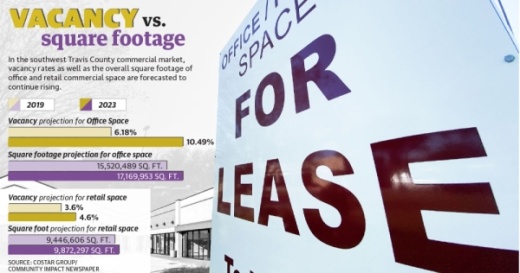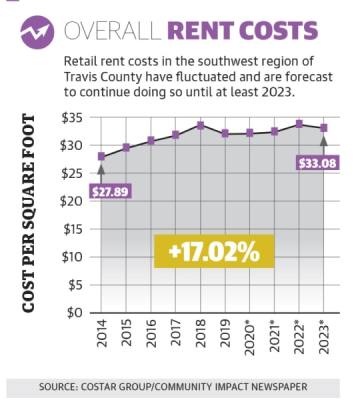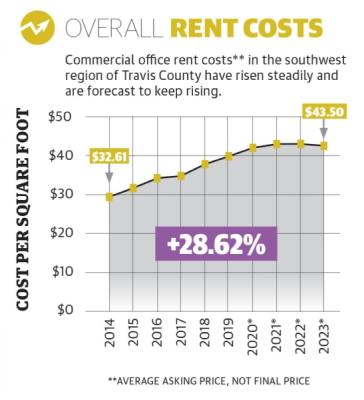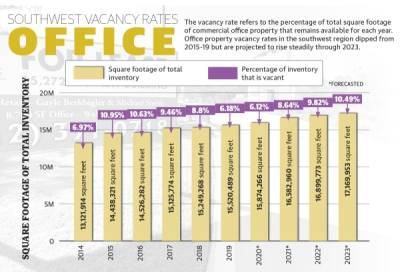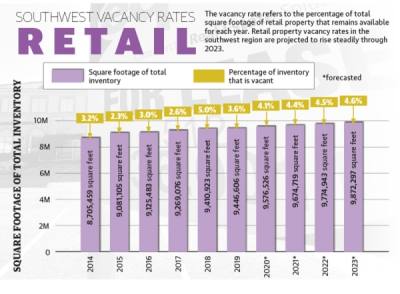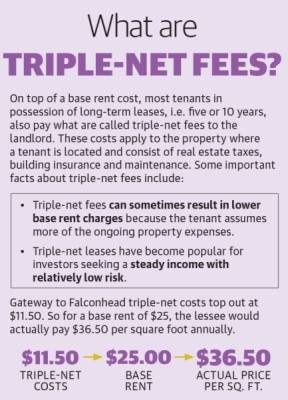She said she is enthusiastic about the pet food and grooming establishment that she owns with her husband, Chris Sherback, but acknowledged there are challenges to opening a new business, especially now.
“Rents are extremely high, so there are barriers to entry [and] people coming in have certain limitations, especially if they’re financially challenged, to start a business,” she said.
Phiroza Sherback said she is happy with her location at the brand-new center, located in north Bee Cave off of RM 620.
“We do have some thriving businesses that are in this Gateway area,” she said, adding it was difficult to see her former neighbor, Lakeway Pharmacy, close down earlier this year. “Lakeway Pharmacy went out of business about eight months ago, and it was really sad to see them go.”
The business ecosystem at Gateway is indicative of most retail and business commercial properties in western Travis County and beyond. Some close, and some survive. Commercial real estate professionals in the area concede that as rents are rising, property values will likely continue to rise, and so too will vacancy percentages within commercial centers.
The evolving face of commerce
Ken Satterlee owns the Gateway to Falconhead center. He said he has owned commercial property for 45 years, but this is his first in the Lake Travis area.
Since Gateway is a brand-new center—its first tenants opened around mid-2018—Satterlee said there are certain criteria he adheres to pertaining to tenants. For example, he does not offer short-term leases. The typical term for a lease for his tenants, he said, is five years.
“I’m not suggesting that there aren’t deals like that getting made,” Satterlee said. “There is a lot of retail up and down RM 620 that has been around for 15 years. They’re on their second, third, fourth tenant.”
Owners of second-generation spaces, or commercial spaces that have had previous tenants, are more likely to be amenable to short-term leases, he said.
Satterlee also said brick-and-mortar retail businesses are having to adjust to the hard growth of online businesses, which is why more and more shops are at least in some part service oriented, such as Sherback’s pet store, which offers grooming.
“Pure retail is kind of going the way of the Edsel, an old car made by Ford,” Satterlee said. “You can’t access a hair salon online. You can’t get your dog groomed online. You can’t eat a meal of sushi—you can order a meal of sushi but you can’t eat it.”
The bottom line, according to Satterlee, is service tenants by and large occupy the lion’s share of smaller spaces in the current commercial retail market.
Still, even if a retail business is more service oriented than pure retail, there is no guarantee it will succeed.
Small-business owner Tony Curtis-Wellings owns Faraday’s Kitchen Store, which operates out of the Shops at the Galleria retail center in Bee Cave on the south side of Hwy. 71.
He and his wife have been at that center for almost seven years and just signed a new lease for six years.
While Satterlee said his commercial property does not deal with short-term leases for new tenants, Curtis-Wellings said they are becoming more common at other types of properties.
“Right now, short-term leases are in pretty good demand because ... I don’t even know of one retailer [at the Shops at the Galleria] that’s opened up in the last two years,” Curtis-Wellings said.
The issue of vacancies and rent prices
One reason Curtis-Wellings said commercial property owners might be more willing to sign short-term leases is because they want to fill the vacancies.
Information gathered from CoStar Group, a commercial real estate data company, shows retail vacancy rates in the southwest region of Travis County from 2018 to 2019 have dropped slightly from 5% to 3.7%, but have risen from 2014, when they were 3.2%. Vacancy rates are projected to rise to about 4.6% by 2023.
The vacancy rates for office properties show an even bigger jump, according to data from CoStar. From 2019-23, projections show the rate increasing from 7% to 10.8%.
Sam Tenenbaum, the director of analytics for the CoStar Group, said that while hard data serves as a solid foundation for those numbers, it is important to remember they are projections.
“There is going to be a broad-based economic slowdown that is baked into the assumptions for the forecast data,” he said.
Regardless of whether the projections from CoStar end up being accurate, a common accessory to most commercial office and retail properties throughout the southwest portion of Travis County are "for lease" signs.
Curtis-Wellings said the problem for many new business owners is twofold: The costs per square foot of commercial property have risen to levels that are higher than normal, and property values are also going up.
“So, not only are we paying more per square foot because the rents have gone up over the last decade, but because the property values in homes and commercial have been going up, the taxes have added to additional expenses every month,” Curtis-Wellings said.
Overall rent costs for area retail properties support that assertion. CoStar data shows retail rent costs rose from $27.86 per square foot in 2014 to $32.30 in 2019.
A similar trend is shown in the southwest region of Travis County pertaining to commercial office space, for which rents jumped from $32.71 per square foot in 2014 to $41.46 in 2019.
One rule of thumb Curtis-Wellings repeatedly invokes involves keeping his rent to within a certain percentage of his gross sales, he said, adding his rent is about 10% of his gross sales. In the modern retail climate, for a startup business that is not a proven franchise, 10%-14% is manageable. So for a business that does $1 million in sales annually, the rent should be between $100,000 and $140,000 for the year. If rent goes higher than 14%, that is when failure becomes more likely, he said.
Curtis-Wellings, who has been a small-business owner for more than three decades, said he has watched that percentage steadily climb over the years.
“Back in the ’80s and ’90s we were focused on 6-8% [rent cost against gross sales], but because property values have gone up so high, that’s really almost impossible unless you’re like a Chick-fil-A or someone who has a big name,” he said.
For small-business owners, it is even more important to have a solid business plan in place because rent is typically not the only payment they make to property owners each month.
Most small-business owners who lease also pay what is called a triple-net payment, which is charged by property owners based on taxes, maintenance and insurance. So if a commercial property charges $10 in triple-net fees, a lease agreement with a base rent of $25 per square foot is actually going to carry a total annual cost of $35 per square foot.
Satterlee said triple-net payments at Gateway to Falconhead are about $11-$11.50 and added at centers such as the Hill Country Galleria, they are even higher.
Strengthening strategies for small-business owners
With vacancy rates and rent costs projected to continue rising through 2023, real estate professionals throughout the area maintain it is crucial for people to create a solid plan for starting a business.
Cathy Coneway, a representative of Stanberry & Associates Realtors, said while it is common for retail and office centers to have vacancies, rising rent costs coupled with triple-net costs are making it more difficult for new business owners to survive, citing as an example of a recent closure the popular Austin restaurant and live music venue Threadgill’s.
“Threadgill’s, who we all loved to go to, could no longer afford to pay their base rent and their triple net,” Coneway said. “I would say retail in particular has been hit hard over the last few years.”
Gayle Berkbigler, the senior vice president at St. Croix Capital Realty advisers, also said it is critical that people know the financials before jumping into business.
Berkbigler is a certified commercial investment member, which she said is an important distinction among commercial real estate professionals. Because of this she makes it a point to educate her clients on terms and concepts such as triple-net fees and holdover clauses in lease agreements.
Given her professional experience in western Travis County, she said other factors can also create pitfalls for small-business owners, including overestimating their square footage needs. But she also said she believes more businesses are failing now than five years ago because they simply cannot maintain the costs.
“The valuations are only going to go up, and they’ve gone up so high in the last four years,” Berkbigler said. “I really think it’s going to be hurting our retail and our offices.”




